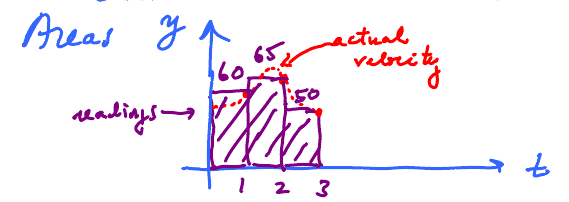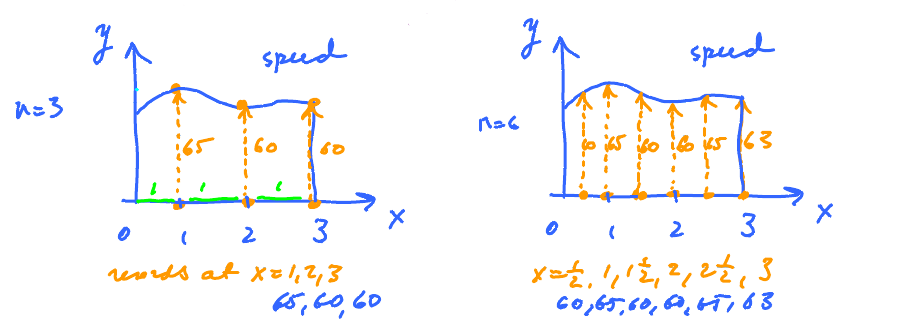This site is being phased out.
Integral: introduction
This is what we have learned about the derivative:
- Geometrically, the derivative is about slopes.
- Algebraically, the derivative is about subtraction.
Indeed: $$\text{slope} = \frac{\text{rise}}{\text{run}} $$ and the numerator is the difference of the values of the function $f(b) - f(a)$.
Compare to differentiation and antidifferentiation: $$\left. \begin{aligned} \text{derivative: } \frac{df}{dx} \to \text{ difference } \to & \text{ subtraction } \\ & \downarrow \\ \text{anti-derivative: } \int f(x)dx \gets \text{ summation } \gets & \text{ addition } \end{aligned} \right. \text{opposite!}$$ The last one is called the integral.
Observations:
- It's the same "d" in "difference" and in $\frac{df}{dx}$.
- It's the same "s" in "summation" and in the integral sign $\int$.
Now where is the summation in antidifferentiation?
Consider again the example of the broken odometer. To know where you are, you have to use a watch and the speedometer. Suppose this is the record of your trip so far:
| Speed | Time frame | Time length |
|---|---|---|
| 60 m/h | 1st hour | 1 |
| 65 m/h | 2nd hour | 1 |
| 50 m/h | 3rd hour | 1 |
How far am I? $$\text{Distance covered } = 60 + 65 + 50 \qquad \text{(addition!)}. $$ But where's antidifferentiation?
We were given the velocity function, in the table, then we found the position function:
Velocity: $$ f(t) = \begin{cases} 60 & 0 \leq t < 1 \\ 65 & 1 \leq t < \\ 50 & 2 \leq t \leq 3 \end{cases} $$
Position: $$ F(t) = \begin{cases} 60t & 0 \leq t < 1 \\ 60 + 65(t-1) & 1 \leq t < 2 \\ & \text{etc}\ldots \end{cases} $$
Then $ F^{\prime} = f$ except for the special points. In other words, the position is an antiderivative of the velocity.
This is what we just learned about the antiderivative:
- Algebraically, the antiderivative is about addition.
- Geometrically, the antiderivative is about areas.
Indeed:
Then, $$ \text{Distance } = 60 + 65 + 60 = \text{ Total of the three rectangles}. $$
Let's take a reading of the speedometer every $\frac{1}{2}$ hour. Then estimate the distance. $$ D = 60\cdot \frac{1}{2} + 65\cdot \frac{1}{2} + 55\cdot \frac{1}{2} = \text{ Total area of these rectangles} $$
Let $n$ be the number of times we record speed.
The true, continuously changing velocity is found from this under the limit $\Delta x \to 0$ or $n \to \infty$.
As $n$ goes to $\infty$, the more rectangles we have and the thinner they are.
$$\begin{alignedat}{2} \text{distance } &\approx \underbrace{65 \cdot 1 + 60 \cdot 1 + 60 \cdot 1}_{\text{areas of rectangles}} & \qquad \text{distance } &\approx \underbrace{65 \cdot \frac{1}{2} + 65 \cdot \frac{1}{2} + 60 \cdot \frac{1}{2} + 65 \cdot \frac{1}{2} + 65 \cdot \frac{1}{2} }_{\text{areas of rectangles}} \end{alignedat} $$
How is the new data better?
The area under the graph is better approximated. In other words, the errors are smaller.
Idea: As $n \to \infty$, $\text{errors } \to 0$.
Now we realize:
finding the position is equivalent to computing the area under the graph of the velocity.
See Integral: definition.



